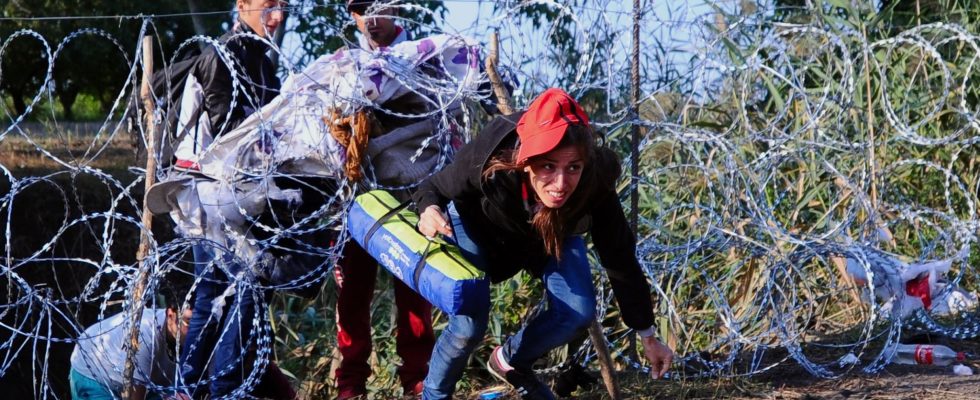In a wood on the outskirts of Ruzsa, a Hungarian village twenty minutes from Serbia, sleeping bags, bottles of water and children’s books lie on the ground. Among the rubbish, an intact identity document, issued by the Serbian immigration police station. The man, of Pakistani nationality, was born on January 1, 2004. A black sedan, abandoned by a smuggler after an accident or a chase with the Hungarian police, is languishing on the edge of the forest.
In 2015, 400,000 illegal immigrants crossed the Hungarian border until a barbed wire fence, erected by the government of Viktor Orbán, then doubled two years later, blocked their route to the Balkans. Slowed down during the pandemic, the flow of migrants has increased since the release by the Magyar state last spring of 1,400 foreign smugglers. The reason ? Their detention too costly for Budapest, which places the blame on “Brussels”. In its current “national consultation” on the “protection of sovereignty”, a pseudo-survey criticizing the EU and the President of the Commission, Ursula von der Leyen, the government accuses, among other things, Europe of wanting to create “ghettos of migrants” in Hungary. How ? By “forcing” the country to “let migrants enter before their asylum application has been processed”, argues the Hungarian executive.
Holes in the fence
Near Ruzsa, 2,400 souls and around sixty vehicles litter the roadsides. Here, gangs of smugglers, particularly Afghans, fight to defend “their” territory and the convoys of migrants. “This summer, children would have died from the heat in this van if we hadn’t gotten them out of there,” says Ferenc, a country guard, pointing to an abandoned vehicle. A few kilometers further, a deserted house serves as a hiding place for migrants. “Without the fence, it would be a disaster,” breathes his colleague Csaba.
According to Gizella Sánta, the mayor of Ruzsa, the fence does not stop migrants, it just slows down the phenomenon. “Migrants are less dangerous here than at the border, because they only transit,” comments the councilor, concerned by the events. Twenty kilometers to the south, the town of Ásotthalom has also been facing a continuous flow since the crisis of summer 2015. At the start of the afternoon, the country guard Sándor Nagy, long beard, fatigues and hunting rifle slung over his shoulder , patrols with his 4×4. “This fence is a joke,” Sándor gets angry, pointing to the many holes patched up by the Magyar authorities. He castigates the Orbán government which “does not give us the means to protect the population” and would like the right to retaliate against migrants. “We don’t want to kill them, just dissuade them,” pleads Sándor.
Understaffed
Administered by the far right since the end of 2013, the population of Ásotthalom is fuming against an incessant migration crisis. Renáta Papp, independent mayor, expressed her anger on November 11 during a demonstration between her municipality and the Serbian village of Bački Vinogradi to obtain “more firmness” from the Magyar executive. “The Ministry of the Interior has never taken into account my requests for reinforced defense. Our citizens are afraid and the police are in danger,” she storms. That evening, however, the border seemed peaceful. Patrols crisscross the area. Orbán’s government wanted 4,000 “border hunters” to support the police, but there are only 1,150 of them taking turns on the 175 kilometers of the barricade. Sándor Nagy nonetheless remains vigilant. “The migrants will come back soon and things will start again,” he complains as he restarts his 4×4.
Despite the flaws in his anti-migrant crusade, Orbán plays the inflexible side. On December 12, Parliament tightened the reception of non-European citizens on Hungarian territory, while the country massively uses “guest workers”, particularly from India and South-East Asia.
As with Ukraine, where Orbán threatens to block accession negotiations and military support at the summit of the Twenty-Seven, on December 14 and 15, the Hungarian leader opposes the community will on the European Migration Pact. However, the text provides for tighter filtering at the gates of the Schengen area, such as the Serbian-Magyar border. Boosted by the triumphs of populists Robert Fico, in Slovakia, and Geert Wilders in the Netherlands, the “illiberal” leader nourishes the hope of an anti-migrant alliance in the European Parliament after the June elections.
.
